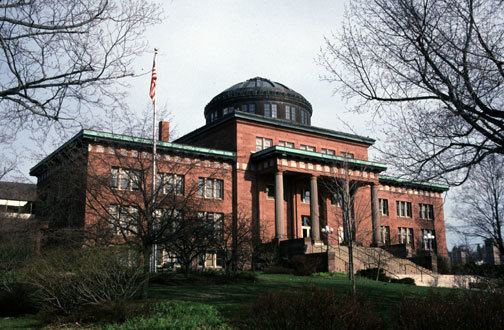Built 1904 | Architectural style Classical Revival | |
 | ||
Area less than 1 acre (0.40 ha) Built by Northern Construction Co. Architect Charlton, Gilbert & Kuenzli | ||
The Marquette County Courthouse is a government building located at 400 South 3rd Street in Marquette, Michigan. It designated a Michigan State Historic Site in 1976 and was listed on the National Register of Historic Places in 1978. The courthouse was the setting of the 1959 film Anatomy of a Murder, directed by Otto Preminger.
Contents
History
In 1857, the first Marquette County courthouse, a wooden Greek Revival structure, was built on this site. By the turn of the century, that structure had become inadequate. In 1902, voters approved the issuance of $120,000 worth of bonds to construct a new courthouse. The earlier structure was moved off the site, and the county hired Marquette architect D. Fred Charlton (Charlton, Gilbert & Demar/Charlton & Kuenzli) to design the building. Northern Construction Company of Milwaukee, Wisconsin, was hired to construct the building. The county eventually spent $240,000 to complete the structure; it was completed in 1904.
The courthouse was the site of a famous 1913 libel case, where President Theodore Roosevelt won a judgment against Ishpeming newspaper publisher George Newett. Roosevelt was awarded six cents, "the price of a good newspaper." Another later case tried here inspired John D. Voelker's novel, Anatomy of a Murder. The 1959 movie version of the novel, directed by Otto Preminger, was filmed in the courthouse.
In 1982–84, the courthouse was renovated at a cost of $2.4 million. A new courthouse and jail was built nearby, connected by a tunnel, but the 1904 building remains in use.
Architecture and design
The Marquette County Courthouse is a Beaux-Arts and Neoclassical structure, with a central three-story mass flanked by two-story wings. It is built almost entirely of local sandstone over a steel frame. A colossal portico covers the entrance, lined with 23-foot (7.0 m) granite Doric columns from Maine. A Doric entablature with copper cornice rings the roofline. A copper dome surmounts the building, and sits above the second-floor courtroom.
Inside, the courtroom is finished with mahogany and marble. Mosaic tiles, wool carpeting, and stained glass fill the building.
